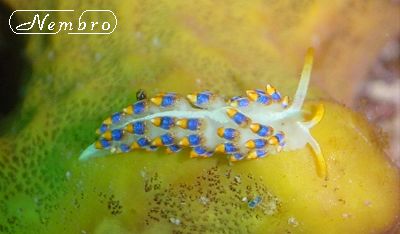
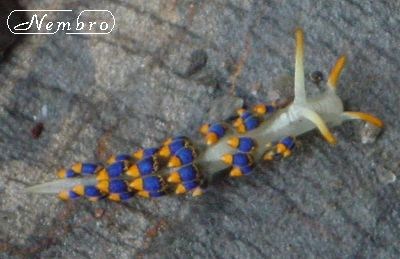
Cuthona caerulea
(Montagu, 1804)
Order: NUDIBRANCHIA
Suborder: AEOLIDINA
Family: Tergipedidae
DISTRIBUTION
Commonly found in western Europe from the western Mediterranean and along the Atlantic coast to sweden and southern Norway. Thompson & Brown (1984) give references to localities in the western Atlantic from Sao Paulo, Brazil to Florida, USA. Usually sublittoral.
PHOTO
Two specimens from Cerbere, on the Mediterranean coast of France. Upper: crawling over the sponge Aplysina aerophoba. July 05, 2002. Site : La Ramere., Depth : 8m, Size : 10-12mm
Lower: July 01, 2002. Site : Les 3 moines., Size : 1cm. Photos: Marina Poddubetskaia
This brilliantly coloured animal grows to about 25mm long. It is quite variable in colour with Thompson & Brown (1984) summarising the variation in the cerata. The digestive gland duct can vary from black, or various shades of blue, to green. The ceratal wall always has a subterminal band of yellow, red or orange. Usually there is band below this of blue, turquoise or green, but it can sometimes be absent. There is a third band bleow this which is always the same colour as the top band, although it can often be fainter and fades towards the ceratal base. Like most tergipedids it feeds on hydroids.
Authorship detailsRudman, W.B., 2000 (May 20) Cuthona caerulea (Montagu, 1804). [In] Sea Slug Forum. Australian Museum, Sydney. Available from http://www.seaslugforum.net/find/cuthcaer
Related messages
Re: Cuthona cf. caerulea from Senegal
June 5, 2009
From: Marina Poddubetskaia
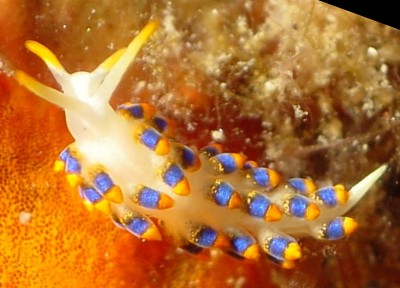
Dear Bill,
Lastly, I found in Cerbere a specimen of Cuthona caerulea which has the same yellowish specks on cerata than one of Senegalese animals [see message #10285]. That tends to confirm your identification. The difference in cerata length between Senegalese and Mediterranean animals of this species puzzles me.
Locality: Cerbere, France, Mediterranean coast. Site: La Ramere. July 10, 2002. Depth: 11 m. Size: 10 mm. Photos: Marina Poddubetskaia
Cheers,
Marina.
Nembro website
nembro@nembro.info
Poddubetskaia, M., 2009 (Jun 5) Re: Cuthona cf. caerulea from Senegal. [Message in] Sea Slug Forum. Australian Museum, Sydney. Available from http://www.seaslugforum.net/find/10640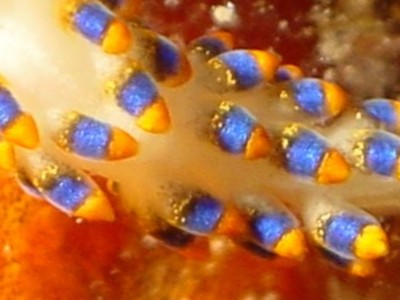 Dear Marina,
My apologies for not posting this sooner. I suspect you don't remember sending it. I found it while preparing Dominique Horst's message today. Concerning the Senegalese animals - I may be quite wrong, but it is suprising how sometimes, cerata can be extended far beyond what we expect to see.
Best wishes
Bill
Rudman, W.B., 2009 (Jun 5). Comment on Re: Cuthona cf. caerulea from Senegal by Marina Poddubetskaia.
[Message in] Sea Slug Forum. Australian Museum, Sydney.
Available from http://www.seaslugforum.net/find/10640
Dear Marina,
My apologies for not posting this sooner. I suspect you don't remember sending it. I found it while preparing Dominique Horst's message today. Concerning the Senegalese animals - I may be quite wrong, but it is suprising how sometimes, cerata can be extended far beyond what we expect to see.
Best wishes
Bill
Rudman, W.B., 2009 (Jun 5). Comment on Re: Cuthona cf. caerulea from Senegal by Marina Poddubetskaia.
[Message in] Sea Slug Forum. Australian Museum, Sydney.
Available from http://www.seaslugforum.net/find/10640
Re: Cuthona caerulea feeding
June 5, 2009
From: Dominique Horst
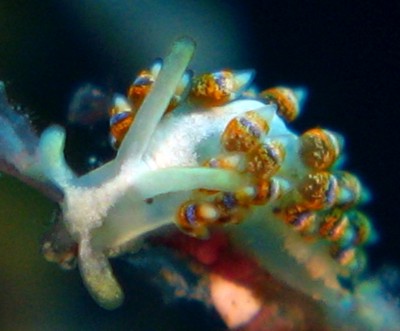
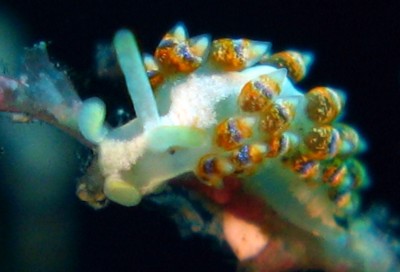
Concerning message #21455:
Hi Bill,
This is a Cuthona caerulea feeding on hydroids.
It should be a juvenile form as it's back is without any cerata and white ?
Locality: Antibes, 13 m, France, Mediterranean sea, 13/04/2009. Length: 4-5 mm. Photographer: Dominique Horst.
Best regards,
Dominique
dominique.horst@wanadoo.fr
Horst, D., 2009 (Jun 5) Re: Cuthona caerulea feeding. [Message in] Sea Slug Forum. Australian Museum, Sydney. Available from http://www.seaslugforum.net/find/22425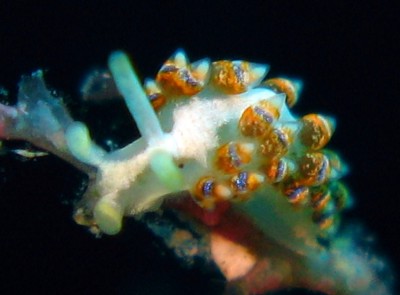
Thanks Dom,
I think the size is the greatest indicator of its age. I can see traces of yellow pigmentation on its head tentacles and some adult specimens of C. caerulea on the Forum have a similar band of white pigmentation down the dorsal midline. Even at this size we can see indications of its brilliant colour pattern
Best wishes,
Bill Rudman.
Re: Cuthona caerulea from French Mediterranean
April 11, 2008
From: Dominique Horst
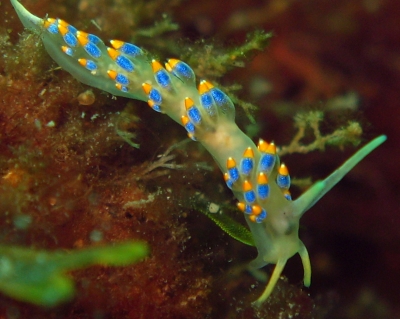
Concerning message #7497:
Hello Bill,
This Cuthona caerulea is a bit different in colour. The yellow of the rhinophore and oral tentacle is not strong. This is probably because it is a juvenile individual. But this one was already a nice size for a juvenile...
Locality: Antibes, 10 m, France, Mediterranean sea, 16 March 2008. Length: 15 mm. Photographer: Dominique Horst.
Kind regards,
/Dom.
dominique.horst@wanadoo.fr
Horst, D., 2008 (Apr 11) Re: Cuthona caerulea from French Mediterranean. [Message in] Sea Slug Forum. Australian Museum, Sydney. Available from http://www.seaslugforum.net/find/21455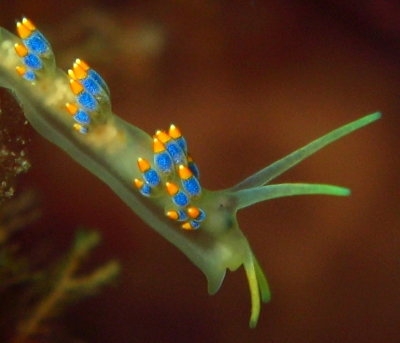
Dear Dom,
From your photo this doesn't look like a juvenile. I suspect the paler yellow is just individual variation. It is a spectacularly coloured speices.
Best wishes,
Bill Rudman
Cuthona cf. caerulea from Senegal
July 2, 2003
From: Marina Poddubetskaia
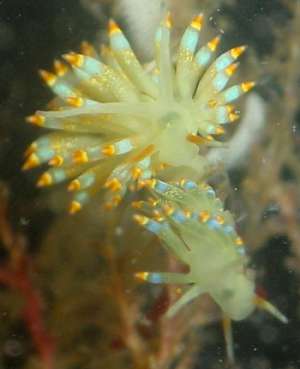
Dear Bill,
Here are small eolids from Dakar. I can't identify them and your help would be very welcome. It looks a little like Cuthona caerulea, but I don't think it is this species because
1. cerata have similar colour but are quite different in shape
2. here, rhinophores aren't tipped with orange and the colour of oral tentacles are a little different too.
I photographed these animals in the tank on their hydroid. There were a lot of specimens on it with many egg-ribbons like in the third photo.
Date: June 04, 2003
Location: Senegal, Eastern Atlantic
Site: Gouye teni M'bot
Depth: 24m
Size: 8-10mm
Photos: Marina Poddubetskaia - Nembro website
Best wishes,
Marina.
nembro@nembro.info
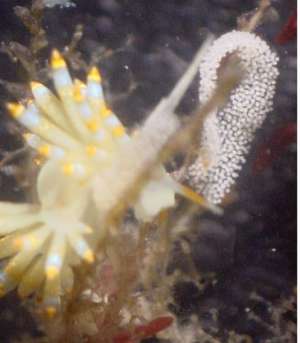
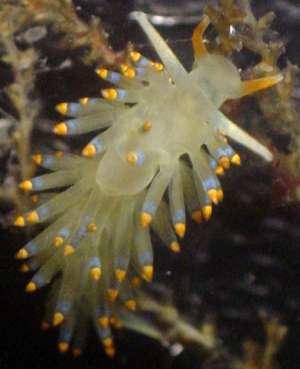
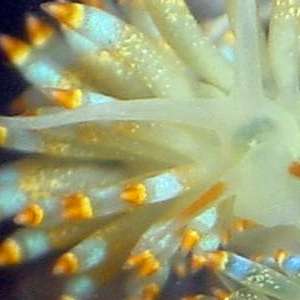
Dear Marina,
I would agree your animals have some differences from 'typical' C. caerulea but that species is quite variable in colour. In fact the animals in your photos show considerable variation. One has a broad blue band on the cerata with many yellowish specks below it, while the other has a thin blue band and no yellowish specks. One has colourless rhinophores while the other is opaque white. Picton & Morrow report C. caerulea as feeding on hydroids of the genus Sertularella. Although its difficult to be sure, the hydroid in your photos could easily be a Sertularella.
I wouls appreciate some comments from colleagues with a knowledge of this species. If it is C. caerulea, I think it is the first record south of Morocco. Marcus (1955) records a single specimen from Brazil, but it is not clear if he is desribing the colour of a live or preserevd specimen.
• Marcus, Er. (1955) Opisthobranchia from Brazil. Boletim da Faculdade de Filosofia, Ciencias e Letras. Universidade de Sao Paulo, Zoologia, 20: 89-261. (Pls. 1-30)
Best wishes,
Bill Rudman
Cuthona caerulea from French Mediterranean
July 19, 2002
From: Marina Poddubetskaia


Dear Bill,
Here are some photos of Cuthona caerulea from Cerbere, on the Mediterranean coast of France
Upper: crawling over the sponge Aplysina aerophoba. July 05, 2002. Site : La Ramere., Depth : 8m, Size : 10-12mm
Lower: July 01, 2002. Site : Les 3 moines., Size : 1cm.
Photos: Marina Poddubetskaia - Nembro website
Best wishes,
Marina.
nembro@nembro.info
Poddubetskaia, M., 2002 (Jul 19) Cuthona caerulea from French Mediterranean. [Message in] Sea Slug Forum. Australian Museum, Sydney. Available from http://www.seaslugforum.net/find/7497Thanks Marina,
Bill Rudman
Cuthona caerulea from Spain
May 20, 2000
From: Erwin Koehler
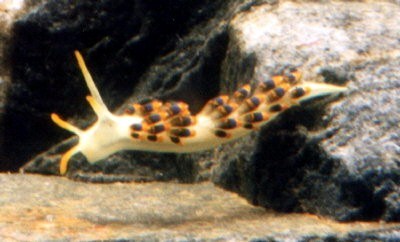
Dear Bill,
Here are some Cuthona caerulea: juvenile (upper), adult (lower left) and spawn (lower right)
dates:
Upper right: divesite "La Trona", April 21, 2000, depth 11m,size 9mm
Lower left: divesite "Cabo Norfeo", May 02, 2000, depth 14m, size 23mm,
Lower right: divesite "La Payita", May 02, 2000, depth 23m, size ~1,5cm
All are from Cala Joncols, Spain.
Erwin
Medslugs.Koehler@t-online.de
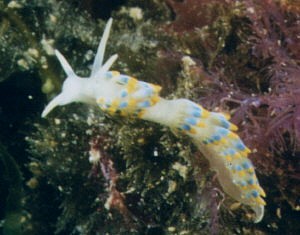
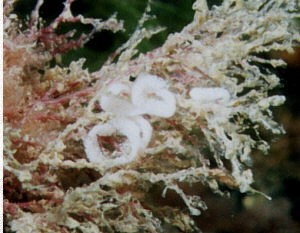
Thanks Erwin,
Bill.
